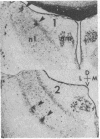Abstract
Neurons of the barn owl's (Tyto alba) nucleus laminaris, the first site of binaural convergence, respond in a phase-locked fashion to a tone delivered to either ear. It may take longer to elicit phase-locked spikes from one ear than from the other. This disparity in delay differs from neuron to neuron and is independent of tonal frequency. In binaural stimulation, neurons respond best when sound in one ear leads that in the other by an amount equal to their delay disparities but opposite in sign. This condition causes simultaneous arrival of phase-locked spikes from the two sides. Laminaris neurons can thus be described as coincidence detectors. The phase of a tone-induced evoked potential, termed "neurophonic," varies systematically with position in nucleus laminaris. From dorsal to ventral within the nucleus, the phase delay of a contralaterally elicited potential decreases and that of its ipsilateral counterpart increases. Therefore, if the neurophonic delay is due to the delay of phase-locked spikes, an orderly representation of delay disparities is shown. Because they act as coincidence detectors, laminaris neurons should show selectivity for interaural phase difference based on their place in the nucleus. Thus, nucleus laminaris presumably measures and maps interaural phase differences by using the principles of delay lines and coincidence detection.
Full text
PDF




Images in this article
Selected References
These references are in PubMed. This may not be the complete list of references from this article.
- Boudreau J. C. Neural volleying: upper frequency limits detectable in the auditory system. Nature. 1965 Dec 18;208(5016):1237–1238. doi: 10.1038/2081237a0. [DOI] [PubMed] [Google Scholar]
- Goldberg J. M., Brown P. B. Response of binaural neurons of dog superior olivary complex to dichotic tonal stimuli: some physiological mechanisms of sound localization. J Neurophysiol. 1969 Jul;32(4):613–636. doi: 10.1152/jn.1969.32.4.613. [DOI] [PubMed] [Google Scholar]
- Moiseff A., Konishi M. Binaural characteristics of units in the owl's brainstem auditory pathway: precursors of restricted spatial receptive fields. J Neurosci. 1983 Dec;3(12):2553–2562. doi: 10.1523/JNEUROSCI.03-12-02553.1983. [DOI] [PMC free article] [PubMed] [Google Scholar]
- Moiseff A., Konishi M. Neuronal and behavioral sensitivity to binaural time differences in the owl. J Neurosci. 1981 Jan;1(1):40–48. doi: 10.1523/JNEUROSCI.01-01-00040.1981. [DOI] [PMC free article] [PubMed] [Google Scholar]
- Parks T. N., Rubel E. W. Organization and development of brain stem auditory nuclei of the chicken: organization of projections from n. magnocellularis to n. laminaris. J Comp Neurol. 1975 Dec 15;164(4):435–448. doi: 10.1002/cne.901640404. [DOI] [PubMed] [Google Scholar]
- Rose J. E., Brugge J. F., Anderson D. J., Hind J. E. Phase-locked response to low-frequency tones in single auditory nerve fibers of the squirrel monkey. J Neurophysiol. 1967 Jul;30(4):769–793. doi: 10.1152/jn.1967.30.4.769. [DOI] [PubMed] [Google Scholar]
- Rose J. E., Gross N. B., Geisler C. D., Hind J. E. Some neural mechanisms in the inferior colliculus of the cat which may be relevant to localization of a sound source. J Neurophysiol. 1966 Mar;29(2):288–314. doi: 10.1152/jn.1966.29.2.288. [DOI] [PubMed] [Google Scholar]
- Snyder R. L., Schreiner C. E. The auditory neurophonic: basic properties. Hear Res. 1984 Sep;15(3):261–280. doi: 10.1016/0378-5955(84)90033-9. [DOI] [PubMed] [Google Scholar]
- Sullivan W. E., Konishi M. Segregation of stimulus phase and intensity coding in the cochlear nucleus of the barn owl. J Neurosci. 1984 Jul;4(7):1787–1799. doi: 10.1523/JNEUROSCI.04-07-01787.1984. [DOI] [PMC free article] [PubMed] [Google Scholar]
- TSUCHITANI C., BOUDREAU J. C. WAVE ACTIVITY IN THE SUPERIOR OLIVARY COMPLEX OF THE CAT. J Neurophysiol. 1964 Sep;27:814–827. doi: 10.1152/jn.1964.27.5.814. [DOI] [PubMed] [Google Scholar]
- Weinberger N. M., Kitzes L. M., Goodman D. A. Some characteristics of the "auditory neurophonic". Experientia. 1970 Jan 15;26(1):46–48. doi: 10.1007/BF01900383. [DOI] [PubMed] [Google Scholar]
- Wernick J. S., Starr A. Binaural interaction in the superior olivary complex of the cat: an analysis of field potentials evoked by binaural-beat stimuli. J Neurophysiol. 1968 May;31(3):428–441. doi: 10.1152/jn.1968.31.3.428. [DOI] [PubMed] [Google Scholar]



